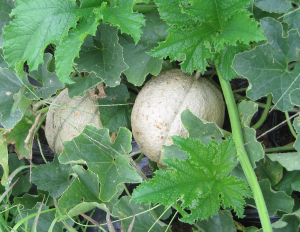Organic Melons — A Niche Market
SARE GRANT FNE10-699
Written by Aaron Englander, UMaine Graduate Student
Introduction
Rufus and Alice Percy own and manage Treble Ridge Farm in Whitefield, ME, 15 miles southeast of Augusta. Their seven-year- old small-scale family farm is a diversified blend of certified organic hogs; selected fruit and vegetable crops (cabbage, pumpkins, winter squash, onions, melons, strawberries and husk cherries); grain (wheat and corn); legumes; and hay. Currently, Treble Ridge Farm distributes their products through a combination of wholesale accounts (Crown of Maine), and 5 farmers markets: Camden, Rockland, South Portland, Hallowell and Common Ground Fair Farmers Market (Pine Gate).
old small-scale family farm is a diversified blend of certified organic hogs; selected fruit and vegetable crops (cabbage, pumpkins, winter squash, onions, melons, strawberries and husk cherries); grain (wheat and corn); legumes; and hay. Currently, Treble Ridge Farm distributes their products through a combination of wholesale accounts (Crown of Maine), and 5 farmers markets: Camden, Rockland, South Portland, Hallowell and Common Ground Fair Farmers Market (Pine Gate).
Like many of Maine’s small direct-marketing farmers, a key factor to the Percy’s success is the increasing demand of the locavore consumer. The importance of niche markets cannot be underestimated for small family operations like Treble Ridge Farm.
Fruit Gaps in the Maine Local Farmers Market
As producers for the Maine niche market, the Percy’s identify and produce crops that will satisfy the enthusiastic, unexpected and sometimes quirky demands of their local markets. According to Alice,
“In this area there is a much closer balance between supply and demand than there are in other places. There’s a lot of up and coming young farmers, a lot of organic farmers and a good many of them are doing produce. But there are still a lot of gaps in the supply and one major gap that we have identified is fruit.”
To fill the gap of fruit supply in the Maine local foods market, Treble Ridge Farm grows day-neutral strawberries, husk cherries and more recently, melons.
The Melon Project
The Percy’s interest of growing organic melons for market led them to their first Farmer/Rancher SARE Grant: Evaluating suitability of open-pollinated melon varieties for intensive organic production. The two-year project was launched in 2010. The main objectives of the project were to develop a greater knowledge base for Maine farmer’s on the production of organic melons and to develop melons as a staple fruit crop in the Maine local foods market.
Melons are not one of Maine’s most common fruit crops, largely because they are difficult to grow in Maine. In 2009, only 5 certified organic farms in Maine planned to grow at least 1000 row feet of melons (MOFGA). A thoroughly evaluated index of climate appropriate varieties and cultural practices for growing melons in Maine was not readily available.
Methods
Alice chose a selection of hybrid and open-pollinated varieties, however, she was especially interested in discovering open-pollinated varieties that could be grown out for seed. Such open-pollinated crops often appeal to the locavore’s taste and preference for flavorful heirloom varieties. As Alice put it, “A fairly well-informed farmer’s market consumer knows Brandywine Tomato, it’s almost like a brand name and it would be really cool if Honeyrock melon became the same thing.”
Alice discussed her interest in the cultivation of open-pollinated melon varieties:
“I’m certainly not an open-pollinated die-hard, there’s nothing better than a hybrid broccoli or sweet corn. But when it comes to cucurbits, I like the open pollinated ones a lot and there’s so much variety and richness and new depth of flavors to be found that I thought it worth exploring, and it really has been.”
Alice used the following parameters to monitor and evaluate twenty-two varieties of melons chosen for fast maturation (<84 days) and/or history of being grown in the northeast.
- Total Yield as calculated by marketable yield per plant
- Sugar Content (Brix measured with Refractometer)
- Consumer ratings (blind taste test, rate 1-lowest to 5-highest)
- Date of first marketable melon from each variety
- Response to disease and insect pressure
- Storage capacity (in 35-40 F cooler)
The melons were started in an unheated greenhouse on May 1st in organic potting soil with ten percent worm casting. On May 21st the melons were transplanted into fine sandy loam soil under black plastic. The soil had been amended in previous years with chicken manure and cover crops to increase organic matter in the well-drained sandy loam. Before the melons were planted, manure-based compost from Living Acres was incorporated at 150 pounds per acre. The melon seedlings were watered in with fish-kelp emulsion. Row-cover was kept on the crops until flowering.
Results
“The trials last year (2010) showed that the hybrids were down around the middle-bottom for flavor and maybe in the middle for yield and there were open-pollinated varieties that blew them out of the water,” reported Alice.
Overall, 2010 was an excellent year for growing fruits and melons in particular. The heat, sunshine and enough rain (but not too much), made for fantastic yields. From the 500 row feet of melons planted, Treble Ridge Farm harvested 1500 pounds of marketable melons. As 2010 was an unusually good growing season, it will be necessary to compare results from 2011 to determine how some of the favored varieties perform under more typical Maine growing season conditions.
For 2010, some of the best melon varieties were open-pollinated. Alice stated her favorites as Honey Rock (sweet, high percent marketable, good yield and taste); Iroquois (incredibly sweet and flavorful; good yields, decent percent marketable); Greeley’s Wonder (large, heavy yielder with only decent flavor and sweetness, tendency to crack); and Silverline (small, early maturing melon that yields well with a high percent marketable and unique flavor). Other promising varieties were Valencia Winter Melon and Pear. One major problem with Heirloom varieties is often a low percent marketable harvest due to cracks or softening. An exception is Honeyrock, which according to Alice, “is aptly named.”
Table 1 below outlines results from the 2010 melon trial taken from their SARE Project Final Report. Storage capacity was not monitored because an equipment failure with the cooler resulted in melon loss to freezing.
As for 2011 results, the cooler season not surprisingly caused a decrease in melon yields. According to Alice “Yields were way down this year, Honey Rock disappointed but Iroquois held strong as did Early Silver Line.” Statistical analysis of the data is currently being processed. Results will be available later this year. This year’s results will help to further determine suitable melon varieties for cultivation in Maine as 2011 was a more typical growing season for the region than 2010.
“We had 19 varieties at once last year to sample. They all look pretty similar, like a melon. But the flavor and the texture was so different, some were watery, fleshy other super sweet. It really surprised me.” — Rufus Percy
Table 1.
| Avg. Sugar Content (Brix) | Flavor (1-lowest to 5-highest) | Avg. Marketable Yield (lbs.) / Plant | Avg. Weight / fruit (lbs.) |
|---|---|---|---|
| Ashkahabad (5.5) | Tigger (1.5) | Noir des Carmes (0) | Tigger (1.30) |
| Tigger (6.4) | Noir des Carmes (2.1) | Ashkahbad (3.0) | Minnesota Midget (1.41) |
| Noir des Carmes (6.6) | Early Silverline (2.1) | Tigger (3.1) | Early Silver Line (1.53) |
| Early Silver Line (8.1) | Prescott Fon Blanc (2.1) | Green Nutmeg (3.3) | Green Nutmeg (1.83) |
| Oka (8.4) | Sweet Granite (2.4) | Prescott Fond Blanc (3.7) | Early Hanover (2.11) |
| Pear (8.5) | Halona (2.5) | Sweet Granite (3.8) | Sweet Granite (2.41) |
| Minnesota Midget (9.1) | Greely’s Wonder (2.8) | Susan Healy (4.4) | Honey Rock (2.43) |
| Greely’s Wonder (9.3) | Oka (3.1) | Halona (4.8) | Burrell’s Jumbo (2.79) |
| Prescott Fond Blanc (9.9) | Susan Healy (3.1) | Early Hanover (5.6) | Jenny Lind (3.18) |
| Early Hanover (10.3) | Maverick (3.1) | Pear (5.7) | Oka (3.27) |
| Susan Healy (10.5 | Jenny Lind (3.1) | Iroquois (5.8) | Maverick (3.32) |
| Green Nutmeg (11.1) | Ashkahabad (3.3) | Jenny Lind (5.9) | Iroquois (3.3) |
| Maverick* (11.3) | Pear (3.3) | Valencia Winter (5.8) | Ashkahabad (3.82) |
| Iroquois (11.7) | Minnesota Midget (3.3) | Oka (6.3) | Prescott Fond Blanc (4.06) |
| Jenny Lind (12.1) | Burrell’s Jumbo (3.4) | Honey Rock (6.3) | Noir des Carmes (4.21) |
| Honey Rock (13.1) | Early Hanover (3.4) | Minnesota Midget (7.1) | Susan Healy (4.28) |
| Valencia Winter (13.5) | Honey Rock (4) | Maverick (7.3) | Pear (4.88) |
| Halona (No Data) | Valencia Winter (4.2) | Early Silver Line (7.9) | Valencia Winter (5.98) |
| Sweet Granite (NoData) | Iroquois (4.7) | Greely’s Wonder(8.5) | Greely’s Wonder (6.6) |
Looking Forward
Overall the organic melon SARE project was successful and produced useful information for Maine growers interested in organic melon production for market. The SARE project highlights a potential revenue stream for Maine farmers: seed production of open-pollinated melon varieties adapted to the cooler northern climate. Treble Ridge Farm identified heirloom varieties such as Honeyrock, Iroquois and Valencia Winter Melon as potential varieties fit for seed production in Maine. The Percy’s shared their results at MOFGA’s Common Ground Country Fair as well as with Fedco and Johnnys seed companies.
Treble Ridge Farm plans to continue growing melons to further diversify their product offerings; fill the supply gap of fruit in the Maine local food market; and grow an annual fruit crop to fit in their 4-year rotation of pastured pigs, cover crops, annual fruits and vegetables and pastured pigs again. The Percy’s hope that their SARE project will serve as “a piece of mobile information that can be used for farmers statewide and regionally.” In an era when locavore consumers are growing in number, production of unique, tasty melons that grow well in northern climates may prove to be a lucrative venture.
For more information about the Percy’s project, see their SARE Project Final Report.
More information about the Northeast SARE Farmer Grant program can be found on the NE-SARE website.
